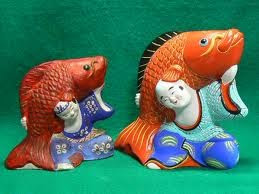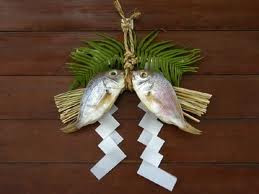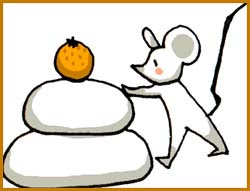Carp 鯉 koi
Dolls and figures with a carps and other fish.
The carp is an old Chinese symbol of endurance, perseverance and fortitude, also success in a good career and people in Japan began to fly carp streamers to wish their child future success.
When the fish carp flow upstream, they use all their physical power to jump over obstacles, even waterfalls.
Dolls with a carp are given to boys to wish for their healthy growth.
There are dolls with figures of children, especially Kintaro, the Strong Boy.
Also Ebisu, deity of the fishermen.
Some toys feature the sea bream, another auspicious fish.
:::::::::::::::::::::::::::::::::::::::::::::::::::::::::::::::::::::::::::::::::::::::::::::::::::::::::::::::::::::::::::::::::::::::::::::::::::::::::::::::::::::::::::::::::::::

Photo : Gabi Greve
. Carp Streamers (koinobori鯉幟) .
Gogatsu koi 五月鯉 carps of the fifth lunar month
kigo for early summer
The most important item for the Boy's Festival
tango no sekku 端午の節句(たんごのせっく)
:::::::::::::::::::::::::::::::::::::::::::::::::::::::::::::::::::::::::::::::::::::::::::::::::::::::::::::::::::::::::::::::::::::::::::::::::::::::::::::::::::::::::::::::::::::
koi daki ningyoo 鯉抱き 人形 doll hugging a carp

. . . CLICK here for Photos !

Tsutsumi dolls from Sendai 宮城・仙台堤人形
Look at more
Folk Toys with FISH :
source : kyoudogangu.xii
- - - - -
. Kuramadera no koi ningyoo 鞍馬寺 鯉の人形 Kurama carp dolls .
Kyoto
:::::::::::::::::::::::::::::::::::::::::::::::::::::::::::::::::::::::::::::::::::::::::::::::::::::::::::::::::::::::::::::::::::::::::::::::::::::::::::::::::::::::::::::::::::::
Ebisu with a carp えびすと鯉
Ebisu, one of the Seven Gods of Good Luck

. Ebisu with Daruma .
Nakano clay doll 中野の土人形
:::::::::::::::::::::::::::::::::::::::::::::::::::::::::::::::::::::::::::::::::::::::::::::::::::::::::::::::::::::::::::::::::::::::::::::::::::::::::::::::::::::::::::::::::::::
Kintaro, the Strong Boy with a Carp
金太郎と鯉

. Kintaroo embracing Daruma だるま抱き金太郎
鯉抱き金太郎
. Tsuyasaki Kintaro with Carp .

- CLICK for more photos -
koi nori dooji 鯉乗り童子 child riding a carp
琉球張子 Ryukru hariko from Okinawa
:::::::::::::::::::::::::::::::::::::::::::::::::::::::::::::::::::::::::::::::::::::::::::::::::::::::::::::::::::::::::::::::::::::::::::::::::::::::::::::::::::::::::::::::::::::
quote
sakana no omocha 魚のおもちゃ toys with fish

Tsuyasaki clay doll 津屋崎人形
帖佐人形の鯛乗り恵比寿 Ebisu riding a sea bream
鯛持ち招き猫 manekineko cat with sea bream
鯛乗り童子 child riding a sea bream
鴻巣の鯛車 "sea bream car" from Konosu town
鯛の土笛 clay whistle with a sea bream
Look at many more samples :
source : koharu
:::::::::::::::::::::::::::::::::::::::::::::::::::::::::::::::::::::::::::::::::::::::::::::::::::::::::::::::::::::::::::::::::::::::::::::::::::::::::::::::::::::::::::::::::::::

. . . CLICK here for Photos !
. Reference .
:::::::::::::::::::::::::::::::::::::::::::::::::::::::::::::::::::::::::::::::::::::::::::::::::::::::::::::::::::::::::::::::::::::::::::::::::::::::::::::::::::::::::::::::::::::
tai mochi ningyoo 鯛持人形 doll holding a sea bream

source : koharu
. . . CLICK here for Photos of sea bream dolls !
..............................................................................................................................................
taiguruma, tai kuruma 鯛車 sea bream on wheels
This comes as a papermachee doll or made from wood, so children can pull it.
The most famous places for their production are
Hayato village in Kagoshima 鹿児島県隼人(はやと)町
The God of Diseases is invited to sit on this red fish and swim away in the nearest river.
. Koonosu town in Saitama 埼玉県鴻巣市 .
.......................................................................
Shimane, Izumo 島根県 出雲
. taiguruma 鯛車 sea bream on wheels .
taichoochin, tai choochin 鯛堤灯
.......................................................................
taiguruma from Kagoshima 鹿児島の鯛車

amulet to prevent disease
It is made of wood and children can pull it along.
It dates back to the legend of Umi no Sachihiko and Yama no Sachihiko. Yama no Sachihiko came down to the ocean and pulled a fishhook out of the mouth of a sea bream.
The toy is made to look with its head bend as if bowing to the Deity who helped him.
Read the details of the story here :
. Umi no Sachi 海の幸, Yama no Sachi 山の幸 .
Kagoshima shrine is dedicated to these deities.
.......................................................................
Niigata 新潟県
Made from bamboo and washi paper.
A candle could be placed inside and children played with it on summer evenings.

from Makicho village 巻町

Sanjooshi 新潟県三条市 from Sanjo
.......................................................................

kingyo daiwa 金魚台輪 goldfish on wheels
Some where quite large and could be pulled around during festivals and during the O-Bon festival for the ancestors.
- quote -
There are various theories as to whether the Kingyo Daiwa was created in the Edo period or the Meiji, but what we do know is that the Kingyo Daiwa, a traditional toy made of a goldfish lamp attached to a small cart, exists only in Shibata, Niigata.
It’s believed that during the Obon period children would light a candle in the lamp and then pull the cart around to play. Kingyo Daiwa started getting much bigger in the Taisho period, and they are now well known for being paraded around by children during festivals in more than 50 towns. There are a number of monuments based on the Kingyo Daiwa around Shibata and it has become a symbol of the city. Miniature Kingyo Daiwa are also popular as souvenirs.
- source : enjoyniigata.com -
..................................................................................................................................................................
ganman no tai (gamman) 願満の鯛
sea bream after the fulfillment of a wish
Usually the word is mangan 満願.

from Kamogawa town, Chiba
The legend takes us back to saint Nichiren.
. Saint Nichiren 日蓮 .
He was born in Awa Kominato 安房小湊, now celebrated at temple Tanjo-Ji 誕生寺 (Birth Temple)。This is one of the most revered temples by the Nichiren sect.
Near the temple is the inlet Tae no Ura 妙の浦(たえのうら), taken from "tai no ura".
The fish amulet has one eye painted in black, the other eye is white.
People pray to the amulet morning and evening, and when the wish is fulfilled, they paint the other eye with black ink and bring the amulet back to the temple.
At Tae no Ura, they believe the tai sea bream is a messenger of Saint Nichiren, or even an incarnation of the Saint himself.
Sea bream is never eaten in this inlet.
It is seldom for sea bream to spawn in such shallow waters, and the fish is under protection there now as a national speciality.
. . . CLICK here for Photos of Taenoura !
Kominato-Zan Tanjoji Temple
source : nichiren-shu.org
By the way, painting the other eye after a wish or vow is fulfilled, reminds us of
. mangan Daruma 満願だるま .
.................................................................................................................................................................
iwaidai 祝鯛 sea bream for celebrations

A papermachee toy from Shizuoka.
The two fish sticking together are an amulet for strong ties in the family.
It has been made in Shizuoka for more than 150 years by the Zawaya 沢屋 family
other versions are
kakedai 掛鯛 sea bream together
as a New Year decoration with real fish.

. WKD : kakedai 懸鯛(かけだい)"hanging sea bream" .
observance kigo for the New Year
..................................................................................................................................................................
. WKD : tai 鯛 sea bream, the fish .

kumade くまで to rake in good luck
Shared by Kyoko Shibata
Joys of Japan, February 2012
:::::::::::::::::::::::::::::::::::::::::::::::::::::::::::::::::::::::::::::::::::::::::::::::::::::::::::::::::::::::::::::::::::::::::::::::::::::::::::::::::::::::::::::::::::::

medetai 目出鯛 auspicious carp
papermachee doll from 三春 Miharu
. Fukushima Folk Art - 福島県 .
:::::::::::::::::::::::::::::::::::::::::::::::::::::::::::::::::::::::::::::::::::::::::::::::::::::::::::::::::::::::::::::::::::::::::::::::::::::::::::::::::::::::::::::::::::::
. Daruma on a namazu catfish fish .
. Kibuna, ki-buna 黄鮒 / 黄ぶな yellow crucian carp amulet .
Tochigi
. Medatai, Mede TAI 目出鯛 auspicious sea bream amulet .
Munakata Taisha 宗像大社, Fukuoka
. Namazu なまず / 鯰 catfish legends and toys .
:::::::::::::::::::::::::::::::::::::::::::::::::::::::::::::::::::::::::::::::::::::::::::::::::::::::::::::::::::::::::::::::::::::::::::::::::::::::::::::::::::::::::::::::::::::
toto awase 魚魚あわせ fish card memory game
toto karuta 魚魚かるた

CLICK for more photos !
- quote -
Toto-Awase is a memory game in which the players have to match two cards to create a complete fish illustration and the kanji character that represents the name of the fish. Each card also has a brief description of the fish depicted. These fish are all familiar species in Japan and their illustrations have been beautifully done with colorful paper patterns. The game was created by Toto Kobo in Tango Uocchikan Aquarium, located in Miyazu City, Kyoto.

Since its début on the market in the Spring of 2003, Toto-Awase, with its beautiful illustrations, has gained popularity. The game has the added benefit for children of teaching them the various fish species and their respective kanji characters. The total sale of Toto-Awase games has now exceeded 100,000. The game received a Good Design Award in 2005 and a Good Toy Award in 2006. Currently there are eleven different sets of the memory game according to different regions. The illustrations are elaborate collages with colorful papers of traditional patterns and the box containing the cards is decorated in vermillion and ultramarine - the quintessential colors of Japan.
An English version is also made under the name “Card Game Sushi Bar” and it is popular as a souvenir for people to bring abroad.
- source : nippon-kichi.jp -

- source : toto kobo 魚魚工房 -

. Karuta, Uta Karuta 歌留多 card games .
:::::::::::::::::::::::::::::::::::::::::::::::::::::::::::::::::::::::::::::::::::::::::::::::::::::::::::::::::::::::::::::::::::::::::::::::::::::::::::::::::::::::::::::::::::::
売れ残るブリキ金魚と梅雨の夜を
urenokoru buriki kingyo to tsuyu no yo o
unsold
tin goldfish and
a night in the rainy season
. Bojo Toshiki 坊城俊樹 .

. kingyo 金魚 goldfish - kigo and art .

kingyo dorei 金魚土鈴 clay bell with a goldfish
. Nara Folk Art - 奈良県 .
.................................................................................................................................................................
- quote -
Gyogyōshin (gyogyoshin ) 漁業神
A general term for tutelaries of fishing invoked by fishermen in hopes of abundant catches and safety on the seas.
A wide variety of kami serve as the centers of cults to fishing deities, including funadama (the guardian spirit of a ship), Ebisu, Ōdama, and Ryūjin (dragon kami).
The funadama is a tutelary of ships which assures safety on the seas. References to the term funadama can be found in the "Register of the Kami (Jinmyōchō) within Engishiki, as well as the Shoku Nihongi. Such early references, however, fail to identify funadama with any specific kami, with the result that commentators have claimed funadama to be identical to Sumiyoshi ōkami, Sarutahiko no kami, and a confusing variety of other kami. In any event, the object of the popular funadama cult is generally believed to be female, and thus to forbid the presence of other females on the boat which she protects. Items serving as the kami's physical representation (shintai) may include women's hair, a pair of dice, a pair of male and female dolls, twelve 1-mon coins, or grains; such items are frequently enshrined by the ship carpenter beneath the central mast before the ship is launched. In the event of an untoward event such as a continuing scarcity of fish or the carrying of a dead body found floating in the sea, the ship's carpenter is usually assigned to replace the funadama, but in earlier times, practitioners of Shugendō or female mediums (miko) were also involved.
Another kami also widely invoked for abundant catches of fish was Ebisu. Today, fishing cults are centered primarily at the shrines Miho Jinja in Izumo, and Nishinomiya Jinja in Hyōgo Prefecture, but in addition to the deities of these specific shrines, the popular world of folk belief viewed as "Ebisu" anything with a mysterious power to produce plentiful catches of fish. As a result, objects of worship could include rocks hauled up in nets, debris washed ashore, drifting corpses, and whales and sharks.
In addition, the cult of Ōdama, a "spirit of the nets" can be found particularly in the Inland Sea region, where a special type of fishing float called ebisu-aba serves as the concrete representation (shintai) of the kami.
In some regions, fishing deities take the form of the "dragon deity" (ryūjin) which originated in beliefs in a deity of water (suijin), while in other areas, fishing boats may affix amulets of such kami as Kotohira, Sumiyoshi, or Inari inside the boat.
- source : Suzuki Kentarō Kokugakuin -
|























































